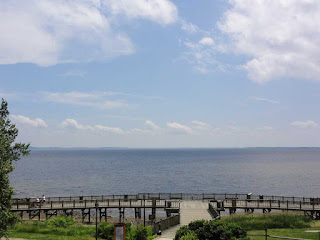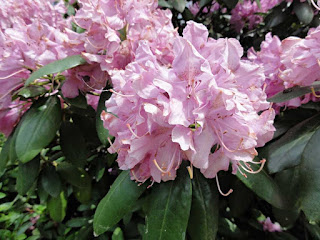 |
| Garden in Havre De Grace |
Havre de Grace (pronounced: Have-ruh-duh-Grayce), Maryland is
a small town you should visit. Located at the confluence of the
Susquehanna River and the
Chesapeake Bay, Havre de Grace has retained its historic charm
though it has long been beside heavily-traveled routes along the Eastern Seaboard.
It was formerly known as Harmer’s Town, named by the settler –
Godfrey Harmer –
who established it in 1658.
The Lower
Susquehanna Ferry first crossed the river in 1695.
The
Marquis De Lafayette visited several times while
traveling up and down the coast to encourage American patriots and fight alongside them. It was he who
suggested that the proposed city along the banks “should be called Havre de
Grace” meaning “Harbor of Grace.” So it was.
Though small in size, Havre de Grace was proposed to be
named the capitol of our new nation. It lost the distinction by one vote to the
swamp along the
Potomac.
Havre de Grace became a terminus of the Susquehanna and Tidewater Canal in 1839. The
Underground Railroad route ushered slaves to
new-found freedom in nearby Pennsylvania.
Nowadays, U.S. 40, I-95 and U.S 1 carry lots of traffic
nearby. It’s amazing that so many people pass without knowing about the
jewel of a town just down the hill.
As proudly noted on the
Explore Havre de Grace web site, Smithsonian.com
listed it among the Best Small Towns in 2014. Rightly so. Interesting shops and
restaurants, museums, special events, walking tours and gardens satisfy
tourists, and of course there’s the beauty of the Chesapeake Bay. Walkers can
enjoy it from the Promenade.
 |
| Havre de Grace Promenade |
One particular feature of this part of the Chesapeake is the
area known as the Susquehanna Flats. Millions of tons of sediment are deposited
at the mouth of the river into the bay covering thousands of acres. Rich with
submerged grasses, The Flats attract many species of wildlife, especially fish
and waterfowl. Fishers and hunters follow.
 |
| Canada Geese |
Havre de Grace is famous as the Decoy Capitol of the World.
There’s no better place to learn about the history of hunting waterfowl and the
decoys that attract them than the
Havre de Grace Decoy Museum.
 |
| Havre De Grace Decoy Museum |
No matter your interest, a good walking tour can begin just
about anywhere. Park your car where it’s legal and start strolling. That’s what
I did. Follow me as we view landmarks and some of the gardens of Havre de Grace.
 |
| Concord Point Lighthouse |
|
 |
| Concord Point Keeper's House |
 |
| Concord Point Park |
 |
| Raised beds in the making. |
 |
| Peonies in bloom |
 |
| Variegated boxwoods |
 |
| Magnificent Fagus sylvatica purpurea |
 |
| Gordonia alatamaha |
 |
| Acer palmatum dissectum atropurpureum |
 |
| Cornus kousa in bloom |
 |
| History is best lived in. |
 |
| Lovely clematis in bloom |
 |
| Small, effective landscape planting |
 |
| Hosta - America's favorite perennial. |
 |
| Iris germanica |
 |
| Quiet street scene |
 |
| Old Bayou Hotel - Hot Spot of the Jazz Age |
|
|
|
 |
| Rhododendron in bloom |



























